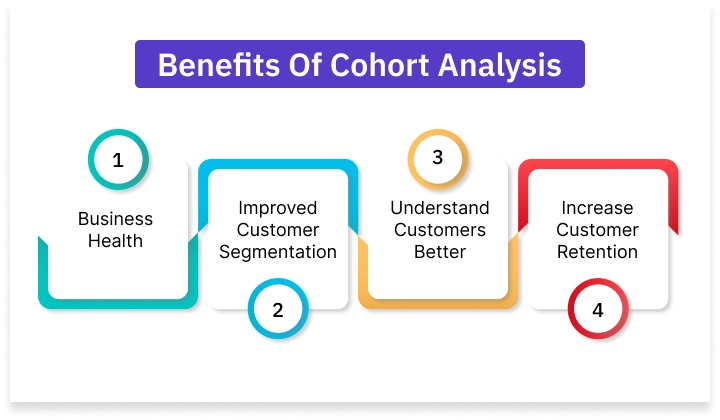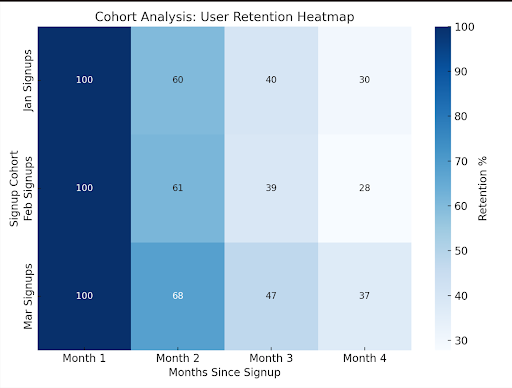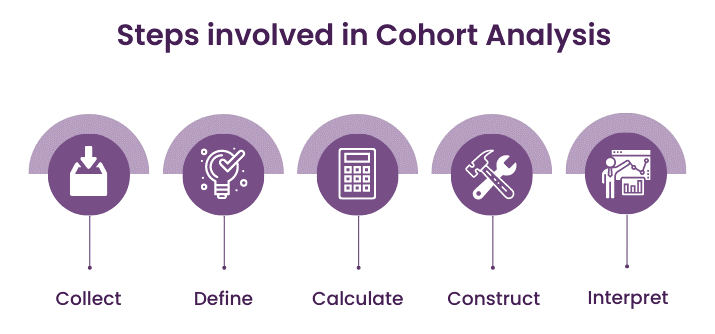Cohort Analysis: Complete 2025 Beginner’s Guide
Table of Contents

Believe it or not, analysis comes before strategy. How? Let’s break it down. Have you ever wondered how businesses manage to influence almost every aspect of your interaction with their products or services? This is where Cohort Analysis comes in. Businesses enjoy using cohort analysis as one of their powerful tools because it’s like having a golden pass to get the best customer experience. But what’s the goal? To put simply, to find similarities and patterns in customer behaviour. Why? So that business can tailor their services and fulfil customers’ requirements to keep them coming.
In this simple guide, we will teach you everything you need to know about Cohort Analysis, including its meaning with an example, its types, and how to use Cohort Analysis. Stay tuned to learn more.
What is Cohort Analysis?

*linkedin.com
Cohort analysis is a strategy that involves analysing behaviours by grouping users with the same characteristics or starting point. If some users are signing up for your products on the same day, same month or hours, they are grouped under the same cohort. After this cohort retention analysis, markets use these data to recognise patterns and track to uncover users’ behaviour. This helps to identify drop-off points and implement improvements to increase growth and retention.
This process of cohort analysis is more impactful for understanding what is really working and what’s not.
Let’s understand Cohort Analysis through an example: Suppose we have an e-commerce site that wants to analyse the behaviour of users who signed up in different months. The aim is to find out how buying power varies and to observe any spikes in churn based on the signup month of users.
In the cohort chart below, users are grouped based on when they were onboarded, so Month 1, Month 2, and Month 3. We are able to identify those who did purchase and the number of users who are now left in the last month or month 4. January signups had 100 total users, but only 30 remained active in month 4. February signups had a total of 45 users left in month 4, which suggests greater retention on average by feb users.
This analysis gives the company a glimpse of the retention pattern, allowing them to compare the purchasing behaviour of cohorts, and brings focus to when churn spikes. The company can now adjust marketing capabilities, improve onboarding, and propose features that will keep the users coming back.

Types of Cohort Analysis
There are mainly three types of cohort analysis that give your answers to different kinds of questions:
Acquisition Cohort Analysis
This type of cohort analysis groups users based on the time they first became active. As an example, you can compare customers who joined in January with those who joined in February. This type of analysis can help a business to get insights into retention, engagement, and purchasing behaviour.
This is especially useful for subscription-based services, mobile applications, and e-commerce businesses where user onboarding periods go hand-in-hand with long-term performance.
Behavioural Cohort Analysis
These types of cohorts are based on the actions taken by users. For example, you may wish to compare customers who made their first purchase in the first week to customers who did not make any purchases right away.
This type of analysis will show patterns of usage, product engagement, and loyalty. It will provide companies with insights into how certain behaviours lead to retention and repeat purchases, which makes it helpful for product managers.
Demographic Cohort Analysis
Demographic cohorts characterise consumers according to their shared personal characteristics such as age, gender, income level, or geographic location. For example, you can get differences between how customers in metro cities use your product compared to customers in a small town.
It is a common method to analyse consumer behaviour in fields such as healthcare, finance, and education, which are affected by external situational factors from the consumer.
How to Use Cohort Analysis in Your Business

*theknowledgeacademy.com
For some, cohort analysis may feel like going technical, but the reality is, it’s all about your understanding of how different groups of users behave over time. So, basically, there are three steps that show how to use cohort analysis. Let’s take a closer look at each of these steps one by one:
Step 1: Define your Cohorts
The first step is about deciding how you want to group users. It can be anything you want, but the most popular grouping criteria include the following:
- Signup date: group users who signed up on the same day, week or month.
- Product usage: segment users based on the product features they are currently using.
- Payment plan: segment customers by free, basic, or premium tiers.
You could also group users by geographic area (city customers vs. rural customers), device type (mobile vs. desktop customers) or any other attribute that is important for your business.
Step 2: Collect Data to Understand how Cohorts Interact With your Product
Once you have your cohort, the next step is collecting data on their product interactions. You’ll need two basic categories:
- Engagement Data: when users logged in, how many times they used certain pages or features, how long they were active, and how often they returned.
- Conversion Data: Events that are directly related to growth: signups, upgrades, purchases, cancellations, etc.
Tools like Google Analytics, Mixpanel or Amplitude will allow you to track engagement metrics or time spent. In addition, your product’s database can track conversions as well as revenue and other financial metrics like customer lifetime value (LTV), that is, total revenue generated by a user during their journey with your product.
Step 3. Analyse and Act on the Data
The fun part comes now – interpreting the data. For that, here are some key metrics you should be aware of:
- Retention rate – what percentage of users in a cohort (e.g. users that signed up in July) stay after a certain period of time.
- Engagement rate – what percentage of users perform a specific action (i.e. use a given feature every week).
- Conversion rate – how many users go to paid from free or trial to subscription.
- LTV – the average revenue created from users in a cohort.
When you track these metrics, you’ll start seeing patterns. Users from referral programs might retain better than your paid ad users. Or people on your annual plan might have better LTV than monthly subscribers.
How Cohort Analysis Helps Businesses And Why You Should Use It
1. Increase Retention Rates
One of the main reasons companies use cohort analysis is to increase retention. Retention analysis and cohort analysis go hand in hand for a reason: they show when and why users leave.
Also, tracking churn timelines allows you to see exactly when users drop off. Do they churn immediately upon sign-up, at the end of their free trial, or a few months down the line? Once you know the “when,” you can then explore the “why.”
2. Spot Trends in Customer Patterns
Cohort analysis also helps you understand patterns about how customers use your product. These patterns can be highly valuable.
For example, you might observe that users who engage with Feature A are much more likely to upgrade to a premium plan, whereas users who do not engage with Feature A will churn more frequently. You might also notice that customers who try Feature B in the first week go on to use other features later, which shows stronger adoption.
3. Identify Drop-Off and Engagement Trends
With time-based cohort analysis, you can see how long users remain active as well as when they’re most likely to stop using your product. This makes mapping the customer lifecycle and identifying drop-off points easier.
For instance, if new users churn just days after signing up, they likely experienced issues during the onboarding process. However, if they churn months later, they may not be finding enough relevant value. Knowing this, you at least know when to act to improve onboarding flows, reminders, and/or engagement campaigns.
4. Increase Product Stickiness and Customer Lifetime Value (LTV)
At the end of the day, cohort analysis provides the context you need to make your product “stickier”. Understanding what keeps users engaged with your product allows you to build in-app nudges, tooltips, and personalised prompts to help users discover features that add real value to them.
As users discover relevant features and develop habits around your product, they will be more likely to stick around (longer). The outcome? Higher customer lifetime value (LTV) and better long-term revenue predictability.
Common Mistakes in Cohort Analysis
Even experts in cohort analysis can run into errors. A frequent error is simply having cohorts which are too broad.
- For example, some people group their users together so there is no chance of recognising true differences in their behaviours upon grouping them.
- If you try to put together so many cohorts, you may also fall under the trap of overfitting, looking for patterns that don’t actually exist in your data.
- Poor data hygiene can also affect your cohort analysis. If you have records under the wrong dates, missing values, or incomplete records, these issues may lead to inaccurate results.
Therefore, it’s best to make sure your cohorts are clean, specific, and (again) connected to your business objectives. You want the insights you acquire to be as clean and useful as possible!
Final Thoughts
Cohort analysis is one of the most intelligent approaches to actually understanding your users. Without doubt, setting your cohorts up will take time, yes – it can feel daunting to think about putting your cohorts together, gathering data accurately, and analysing it consistently. But it is worth it.
If done the right way, cohort analysis provides valuable insights that help you make smarter decisions, improve retention, and accelerate business growth. To learn more about cohort analysis, explore the online courses available at Jaro Education. We offer a wide range of programs in data analysis, digital marketing, and product management.
Frequently Asked Questions
How to Select the Right Tool for Cohort Analysis?
Choose a tool that fits your business needs. If you need basic tracking, Google Analytics works well. For deeper insights, platforms like Mixpanel, Amplitude, or Userpilot provide advanced cohort segmentation and retention tracking.
What are some common mistakes to avoid in cohort analysis?
Don’t pick time periods that are too broad, as this hides important details. Avoid grouping users incorrectly or using incomplete data. Another mistake is focusing only on churn without studying what drives cohort retention analysis.
What’s the difference between Cohort Analysis and Traditional Analytics?
Traditional analytics gives you overall metrics, like total signups or active users. Cohort analysis digs deeper by grouping users over time, helping you see patterns in retention and behaviour.
What’s the use of behavioural cohorts?
Behavioural cohorts group users by actions, like completing onboarding or making a purchase. They reveal which behaviours lead to long-term engagement and which increase churn.

















